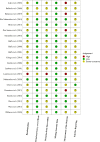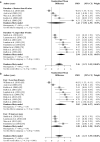The Ergogenic Effects of Acute Carbohydrate Feeding on Resistance Exercise Performance: A Systematic Review and Meta-analysis
- PMID: 35809162
- PMCID: PMC9584980
- DOI: 10.1007/s40279-022-01716-w
The Ergogenic Effects of Acute Carbohydrate Feeding on Resistance Exercise Performance: A Systematic Review and Meta-analysis
Abstract
Background: Carbohydrate (CHO) ingestion has an ergogenic effect on endurance training performance. Less is known about the effect of acute CHO ingestion on resistance training (RT) performance and equivocal results are reported in the literature.
Objective: The current systematic review and meta-analysis sought to determine if and to what degree CHO ingestion influences RT performance.
Methods: PubMed, MEDLINE, SportDiscus, Scopus, and CINAHL databases were searched for peer-reviewed articles written in English that used a cross-over design to assess the acute effect of CHO ingestion on RT performance outcomes (e.g., muscle strength, power, and endurance) in healthy human participants compared to a placebo or water-only conditions. The Cochrane Collaboration's risk of bias tool and GRADE approaches were used to assess risk of bias and certainty of evidence, respectively. Random effects meta-analyses were performed for total training session volume and post-exercise blood lactate and glucose. Sub-group meta-analysis and meta-regression were performed for categorical (session and fast durations) and continuous (total number of maximal effort sets, load used, and CHO dose) covariates, respectively.
Results: Twenty-one studies met the inclusion criteria (n = 226 participants). Pooled results revealed a significant benefit of CHO ingestion in comparison to a placebo or control for total session training volume (standardised mean difference [SMD] = 0.61). Sub-group analysis revealed a significant benefit of CHO ingestion during sessions longer than 45 min (SMD = 1.02) and after a fast duration of 8 h or longer (SMD = 0.39). Pooled results revealed elevated post-exercise blood lactate (SMD = 0.58) and blood glucose (SMD = 2.36) with CHO ingestion. Meta-regression indicated that the number of maximal effort sets, but not CHO dose or load used, moderates the effect of CHO ingestion on RT performance (beta co-efficient [b] = 0.11). Carbohydrate dose does not moderate post-exercise lactate accumulation nor do maximal effort sets completed, load used, and CHO dose moderate the effect of CHO ingestion on post-exercise blood glucose.
Conclusions: Carbohydrate ingestion has an ergogenic effect on RT performance by enhancing volume performance, which is more likely to occur when sessions exceed 45 min and where the fast duration is ≥ 8 h. Further, the effect is moderated by the number of maximal effort sets completed, but not the load used or CHO dose. Post-exercise blood lactate is elevated following CHO ingestion but may come at the expense of an extended time-course of recovery due to the additional training volume performed. Post-exercise blood glucose is elevated when CHO is ingested during RT, but it is presently unclear if it has an impact on RT performance.
Protocol registration: The original protocol was prospectively registered on the Open Science Framework (Project identifier: https://doi.org/10.17605/OSF.IO/HJFBW ).
© 2022. The Author(s).
Conflict of interest statement
Andrew King, Eric Helms, Caryn Zinn, and Ivan Jukic declare that they have no conflicts of interest relevant to the content of this review.
Figures







Similar articles
-
Synergy of carbohydrate and caffeine ingestion on physical performance and metabolic responses to exercise: A systematic review with meta-analysis.Crit Rev Food Sci Nutr. 2024;64(10):2941-2959. doi: 10.1080/10408398.2022.2128298. Epub 2022 Sep 30. Crit Rev Food Sci Nutr. 2024. PMID: 36178302
-
Impact of Cold-Water Immersion Compared with Passive Recovery Following a Single Bout of Strenuous Exercise on Athletic Performance in Physically Active Participants: A Systematic Review with Meta-analysis and Meta-regression.Sports Med. 2022 Jul;52(7):1667-1688. doi: 10.1007/s40279-022-01644-9. Epub 2022 Feb 14. Sports Med. 2022. PMID: 35157264 Free PMC article.
-
The Effect of Sodium Alginate and Pectin Added to a Carbohydrate Beverage on Endurance Performance, Substrate Oxidation and Blood Glucose Concentration: A Systematic Review and Meta-analysis.Sports Med Open. 2022 Jun 21;8(1):82. doi: 10.1186/s40798-022-00472-5. Sports Med Open. 2022. PMID: 35727377 Free PMC article.
-
Acute Effects of Caffeine Supplementation on Movement Velocity in Resistance Exercise: A Systematic Review and Meta-analysis.Sports Med. 2020 Apr;50(4):717-729. doi: 10.1007/s40279-019-01211-9. Sports Med. 2020. PMID: 31643020
-
The Acute and Chronic Effects of Implementing Velocity Loss Thresholds During Resistance Training: A Systematic Review, Meta-Analysis, and Critical Evaluation of the Literature.Sports Med. 2023 Jan;53(1):177-214. doi: 10.1007/s40279-022-01754-4. Epub 2022 Sep 30. Sports Med. 2023. PMID: 36178597 Free PMC article.
Cited by
-
Acute Effects of 30 g Cyclodextrin Intake during CrossFit® Training on Performance and Fatigue.J Funct Morphol Kinesiol. 2024 Jan 30;9(1):27. doi: 10.3390/jfmk9010027. J Funct Morphol Kinesiol. 2024. PMID: 38390927 Free PMC article.
-
Peak Week Carbohydrate Manipulation Practices in Physique Athletes: A Narrative Review.Sports Med Open. 2024 Jan 13;10(1):8. doi: 10.1186/s40798-024-00674-z. Sports Med Open. 2024. PMID: 38218750 Free PMC article. Review.
-
Knowledge of gym goers on myths and truths in resistance training.Sci Rep. 2025 Jan 27;15(1):3401. doi: 10.1038/s41598-025-87485-8. Sci Rep. 2025. PMID: 39870800 Free PMC article.
-
Nutrition in CrossFit® - scientific evidence and practical perspectives: a systematic scoping review.J Int Soc Sports Nutr. 2025 Dec;22(1):2509674. doi: 10.1080/15502783.2025.2509674. Epub 2025 Jun 5. J Int Soc Sports Nutr. 2025. PMID: 40471841 Free PMC article.
-
Effect of Small and Large Energy Surpluses on Strength, Muscle, and Skinfold Thickness in Resistance-Trained Individuals: A Parallel Groups Design.Sports Med Open. 2023 Nov 2;9(1):102. doi: 10.1186/s40798-023-00651-y. Sports Med Open. 2023. PMID: 37914977 Free PMC article.
References
Publication types
MeSH terms
Substances
LinkOut - more resources
Full Text Sources
Miscellaneous

